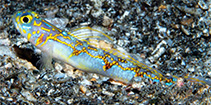| Family: |
Gobiidae (Gobies), subfamily: Gobiinae |
| Max. size: |
3.22 cm SL (male/unsexed); 2.78 cm SL (female) |
| Environment: |
reef-associated; marine; depth range 35 - 60 m |
| Distribution: |
Western Central Pacific: Papua New Guinea. |
| Diagnosis: |
Dorsal spines (total): 7-7; Dorsal soft rays (total): 10-12; Anal spines: 1-1; Anal soft rays: 11-11. This species is distinguished by the following characters: D VI-I,10-12, with fourth dorsal-fin spine filamentous, reaching base of about fifth to seventh segmented dorsal-fin ray when adpressed; A I,11; pectoral-fin rays 16-18; lateral scales 35-37; transverse scales 10; body scales mostly ctenoid, except with cycloid scales anterior to level of about second dorsal-fin origin, on pectoral-fin base, prepelvic region, and lower side between pectoral and pelvic fins; no scales on head, including medially and anteriorly on predorsal region; caudal fin lanceolate with an elongate median filament. Colour in life is light neon blue with wavy yellow-orange stripe from upper operculum to upper caudal-fin base; with prominent yellow-orange bars, bands, and spots on head and upper sides; a pair of yellow stripes on the second dorsal fin; yellow streaks and bands on caudal fin (Ref. 122681). |
| Biology: |
Inhabits relatively steep outer reef slope with fish occupying burrows on black volcanic sand/
rubble substrates. About 20 individuals were observed in an area that occupied about 600 sq.m. Solitary individuals encountered were invariably associated with an unidentified snapping shrimp of the genus Alpheus that share the burrows, a symbiotic relationship found in all Vanderhorstia species (Ref. 122681). |
| IUCN Red List Status: |
Not Evaluated (N.E.) Ref. (130435)
|
| Threat to humans: |
harmless |
| Country info: |
|
Source and more info: www.fishbase.org. For personal, classroom, and other internal use only. Not for publication.

